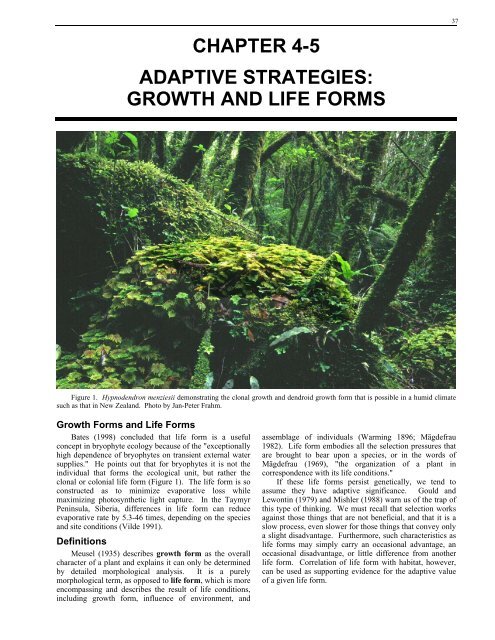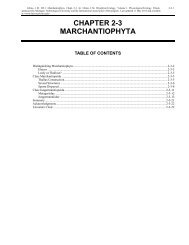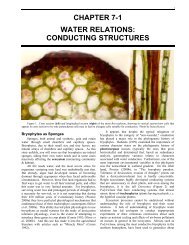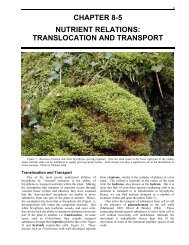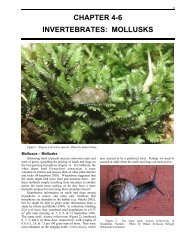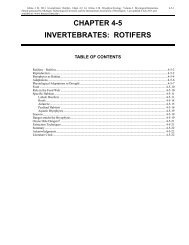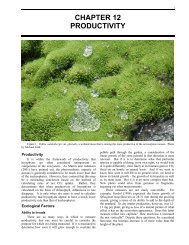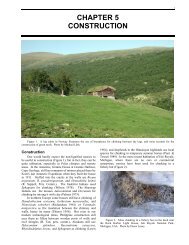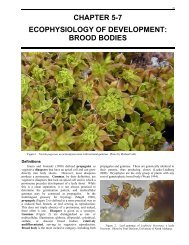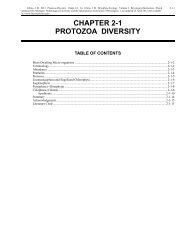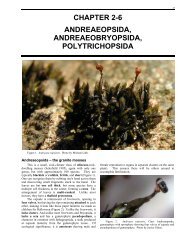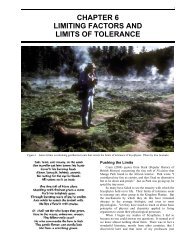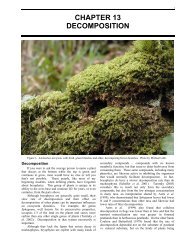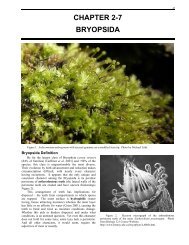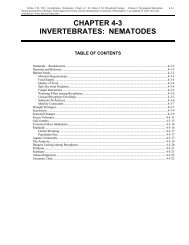Chapter 4-5: Adaptive Strategies - Bryophyte Ecology
Chapter 4-5: Adaptive Strategies - Bryophyte Ecology
Chapter 4-5: Adaptive Strategies - Bryophyte Ecology
Create successful ePaper yourself
Turn your PDF publications into a flip-book with our unique Google optimized e-Paper software.
CHAPTER 4-5<br />
ADAPTIVE STRATEGIES:<br />
GROWTH AND LIFE FORMS<br />
Figure 1. Hypnodendron menziesii demonstrating the clonal growth and dendroid growth form that is possible in a humid climate<br />
such as that in New Zealand. Photo by Jan-Peter Frahm.<br />
Growth Forms and Life Forms<br />
Bates (1998) concluded that life form is a useful<br />
concept in bryophyte ecology because of the "exceptionally<br />
high dependence of bryophytes on transient external water<br />
supplies." He points out that for bryophytes it is not the<br />
individual that forms the ecological unit, but rather the<br />
clonal or colonial life form (Figure 1). The life form is so<br />
constructed as to minimize evaporative loss while<br />
maximizing photosynthetic light capture. In the Taymyr<br />
Peninsula, Siberia, differences in life form can reduce<br />
evaporative rate by 5.3-46 times, depending on the species<br />
and site conditions (Vilde 1991).<br />
Definitions<br />
Meusel (1935) describes growth form as the overall<br />
character of a plant and explains it can only be determined<br />
by detailed morphological analysis. It is a purely<br />
morphological term, as opposed to life form, which is more<br />
encompassing and describes the result of life conditions,<br />
including growth form, influence of environment, and<br />
assemblage of individuals (Warming 1896; Mägdefrau<br />
1982). Life form embodies all the selection pressures that<br />
are brought to bear upon a species, or in the words of<br />
Mägdefrau (1969), "the organization of a plant in<br />
correspondence with its life conditions."<br />
If these life forms persist genetically, we tend to<br />
assume they have adaptive significance. Gould and<br />
Lewontin (1979) and Mishler (1988) warn us of the trap of<br />
this type of thinking. We must recall that selection works<br />
against those things that are not beneficial, and that it is a<br />
slow process, even slower for those things that convey only<br />
a slight disadvantage. Furthermore, such characteristics as<br />
life forms may simply carry an occasional advantage, an<br />
occasional disadvantage, or little difference from another<br />
life form. Correlation of life form with habitat, however,<br />
can be used as supporting evidence for the adaptive value<br />
of a given life form.<br />
37
38 <strong>Chapter</strong> 4-5: <strong>Adaptive</strong> <strong>Strategies</strong>: Growth and Life Forms<br />
Early classification of life forms had little relevance<br />
for bryophytes. Dansereau (1957, in Ricklefs 1990)<br />
classified plant life forms into trees, shrubs, herbs,<br />
epiphytes, lianas (vines), deciduous, evergreen, and<br />
bryoids. Raunkiaer (1934) relied primarily on winter<br />
characteristics and based his system on bud position:<br />
phanerophytes (phanero = visible) – tips of branches;<br />
moist, warm environments<br />
chamaephytes (chamae = dwarf) – shrubs and herbs, buds<br />
near soil; cool, dry climates<br />
hemicryptophytes (hemicrypto = half hidden) – die back<br />
to ground in winter; cold, moist<br />
cryptophytes (crypto = hidden) – buds buried by soil; cold,<br />
moist<br />
therophytes (thero = summer) – seeds; deserts, grassland<br />
Jargon of Life History<br />
First, perhaps it is necessary to distinguish between life<br />
history (or life cycle) traits and life forms. As During<br />
(1979) points out, holomorphy (total form, Hennig 1966;<br />
the German Gestalt) of plants resulting from their<br />
adaptations to their environments certainly relates to their<br />
strategies. However, the life strategy refers to life cycle<br />
characteristics and their timing (treated in the next chapter),<br />
whereas life form refers to the morphological characters of<br />
individuals as well. La Farge-England (1996) points out<br />
the inconsistencies in the literature regarding the term life<br />
form and supports Barkman (1979) by defining it as "the<br />
overall organization of growth form, branching pattern,<br />
general assemblage of individuals, and modification of a<br />
population by the environment." Growth form, she<br />
reminds us, is "the structural architecture of the individual<br />
moss plant." But such architectures can be modified by the<br />
environment, hence merging life form and growth form<br />
(Tangney 1998). It would seem simpler to define one as<br />
the genetically programmed form and one as the<br />
environmentally modified form, but the muddle in the<br />
literature has crossed those lines with both terms. Thus,<br />
even with the foregoing definitions, confusion in the use of<br />
terms will still be with us and I shall make little attempt to<br />
unravel their use in the literature presented here.<br />
Therefore, interpretation of their use should be done with<br />
caution.<br />
Growth Forms<br />
Since growth form is the simpler result of genetics, we<br />
should examine that first. As La Farge-England (1996)<br />
stated, the terminology of growth form, branching pattern,<br />
and position of perichaetia have been used inconsistently in<br />
the literature. This morass of literature makes it difficult to<br />
compare studies and to sort out the real meanings in<br />
nomenclature. After an extensive review of the literature<br />
and usage of the terminology, she recommended the<br />
following interpretations:<br />
1. Growth form is distinct from life form.<br />
2. Direction of growth does not necessarily imply<br />
perichaetial position; some acrocarpous mosses<br />
(having terminal perichaetia) grow horizontally,<br />
whereas some pleurocarpous ones (having<br />
perichaetia in lateral buds or on short side branches)<br />
grow erect.<br />
3. Cladocarpy (Figure 2) is distinct from pleurocarpy,<br />
with perichaetia terminal on lateral branches and with<br />
juvenile leaf development similar to that on vegetative<br />
branches; perichaetial branches have lateral primordia<br />
that potentially develop subperichaetial branches. (It<br />
is defined in Glossarium Polyglottum Bryologiae as a<br />
type of pleurocarpy having sporophytes borne<br />
terminally on short lateral branches, as in Fontinalis).<br />
4. Pleurocarpy is defined as having perichaetia terminal<br />
on lateral innovations that appear sessile and swollen<br />
along supporting axes. Juvenile leaves are<br />
morphologically different from those of vegetative<br />
branches. Perichaetial innovations lack lateral branch<br />
primordia and thus do not produce subperichaetial<br />
branches. Pleurocarpy is restricted to Hypnales,<br />
Hookeriales, and Leucodontales, including<br />
Spiridentaceae and Racopilaceae.<br />
Figure 2. Cladocarpous branches of Macromitrium<br />
microstomum. Photo by Janice Glime.<br />
But traditionally, growth forms of mosses have been<br />
divided into those that are acrocarpous (Figure 3) and<br />
stand vertically (orthotropic mosses) and those that are<br />
pleurocarpous and lie horizontally relative to the substrate<br />
(plagiotropic mosses; Figure 4) (Meusel 1935). This of<br />
course leaves a few out of the scheme, as noted by La<br />
Farge-England. The orthotropic mosses can be further<br />
divided into the protonema mosses (Figure 5), with short<br />
or non-existent shoots that wither after the sporophyte is<br />
produced, and turf mosses, with upright shoots that bear<br />
new shoots after the sporophyte forms and subsequently<br />
bear further archegonia and more sporophytes; these new<br />
growths are the innovations. The plagiotropic mosses<br />
(Figure 4) include thread mosses (e.g. Leskeaceae, some<br />
Amblystegiaceae), with little difference between the main<br />
stem and lateral branches, the comb mosses (e.g.<br />
Hypnaceae, Brachytheciaceae, Meteoriaceae), with a strong<br />
main shoot with many simple or branched lateral branches,<br />
and the creeping-shoot mosses (e.g. Leucodon, Antitrichia,<br />
Climaciaceae, Hypnodendraceae), with rhizomatous main<br />
shoots that give rise to upright main shoots.<br />
Figure 3. Acrocarpous growth form exhibited by<br />
Oncophorus wahlenbergii. Photo by Michael Lüth.
<strong>Chapter</strong> 4-5: <strong>Adaptive</strong> <strong>Strategies</strong>: Growth and Life Forms 39<br />
Figure 4. Plagiotropic, pleurocarpous, perennial mosses. a & b. creeping shoot mosses – Antitrichia curtipendula. c. creeping<br />
shoot moss – Climacium dendroides. d. creeping shoot moss – Leucodon brachypus var. andrewsianus. e. thread moss –<br />
Amblystegium serpens. f. thread moss – Leskea polycarpa. g. comb moss –Brachythecium reflexum. h. comb moss – Hypnum<br />
sauteri. a, b, e-g photos by Michael Lüth; c, d photos by Janice Glime.
40 <strong>Chapter</strong> 4-5: <strong>Adaptive</strong> <strong>Strategies</strong>: Growth and Life Forms<br />
Figure 5. Protonema mosses. Upper: Pogonatum aloides.<br />
Lower: Buxbaumia aphylla. Photos by Michael Lüth.<br />
The same species may exhibit more than one growth<br />
form. For example, in some populations Hylocomium<br />
splendens (Figure 6) exhibits monopodial growth (single<br />
central axis with apical growth) (Ross et al. 1998, 2001).<br />
However, some populations can continue by sympodial<br />
growth (growth produced by lateral buds just behind apex).<br />
In forest habitats of temperate to mid-arctic regions the<br />
growth is primarily sympodial, creating the stair-step form<br />
that easily delineates annual growth (Ross et al. 2001).<br />
Higher nutrient availability promoted sympodial growth.<br />
In tundra and high arctic habitats, monopodial growth<br />
predominates and increments cannot easily be discerned.<br />
Transplant experiments demonstrated that these traits were<br />
plastic, but that natural variability was greater among those<br />
shoots in natural populations at transplant sites, indicating a<br />
genetic component as well as an environmental component<br />
to the differences, affecting both growth and life forms.<br />
Figure 6. Weft life form of Hylocomium splendens. Photo<br />
by Michael Lüth.<br />
Ross et al. (1998) found that the sympodial<br />
Hylocomium splendens plants had increasing stiffness with<br />
stem segment age and flexibility decreased with age up<br />
through four years, then declined. However, monopodial<br />
plants showed neither of these age effects and no increase<br />
in stem diameter with age. The sympodial stems had<br />
significantly more cellulose than their monopodial<br />
counterparts, providing them with a higher stress yield.<br />
The predominance of these two forms differs with habitat,<br />
with more northern populations lacking the sympodial<br />
branching that defines the annual increments. Økland<br />
(2000) further determined that reproductive capacity differs<br />
with stem position and age. The apical tips are subject to<br />
greater exposure and are less likely to have successful<br />
reproduction. Reproductive failure is greatest for older<br />
segments buried within the weft (44%), lowest for<br />
intermediate vertical positions (12%), and relatively high<br />
for the emergent segments. The greatest annual increment<br />
is likewise at this intermediate level (2-10 mm below the<br />
bryophyte surface) where there is still sufficient light but<br />
the loss of water is minimized.<br />
Økland (2000) pointed out the importance of "growth<br />
form" in the way that pleurocarpous and acrocarpous<br />
bryophytes interact in competition. In our study on Isle<br />
Royale (Raeymaekers, Zhang, & Glime unpubl), the<br />
interaction between the acrocarpous Dicranum polysetum<br />
and the pleurocarpous Pleurozium schreberi (Figure 7)<br />
differed from year to year, most likely depending on the<br />
precipitation patterns. In some years, D. polysetum<br />
increased in area and overran P. schreberi, but in other<br />
years the reverse occurred. Økland suggested that the<br />
relationship of upper segments to lower ones represented<br />
amensalism, where the lower segments were harmed.<br />
Small segments were more easily buried. This relationship<br />
can play an important role in both infraspecific and<br />
interspecific<br />
interactions among bryophytes.<br />
Figure 7. Pleurozium schreberi competing with Dicranum<br />
polysetum. Photo by Herschel Horton.
Life Forms<br />
Literature on life forms and growth forms is confusing<br />
because different authors have used the terms in different<br />
ways, sometimes in reverse of the descriptions above.<br />
Even in the long-studied tracheophytes, the terms have<br />
often been used as if they are interchangeable. In studying<br />
loblolly pine trees, Haney et al. (1993) illustrated effects of<br />
density on "growth form" of loblolly pine tree shape. They<br />
found that in low densities, trees were shorter and had more<br />
branches. At medium density, they were taller, but<br />
branches were few in number. At high densities, trees were<br />
tallest and branches were still few (Figure 8). These<br />
environmental influences on tree form fit the more<br />
encompassing definition of life form described above by La<br />
Farge-England (1996). As expected, allocation of biomass<br />
changes relative to density (Table 1), resulting in a<br />
different form. Such mosses as Sphagnum and Climacium<br />
would be interesting tests of a similar form change in<br />
bryophytes. Climacium is known to change form, but it<br />
appears to be under both environmental and genetic<br />
control;<br />
effect of crowding was not studied (Shaw 1987).<br />
Figure 8. Illustration of forms in loblolly pine at different<br />
densities. Based on Haney et al. (1993).<br />
Table 1. Allocation of biomass in trees of loblolly pine at<br />
three density levels (Haney et al. 1993).<br />
<strong>Chapter</strong> 4-5: <strong>Adaptive</strong> <strong>Strategies</strong>: Growth and Life Forms 41<br />
low medium high<br />
diameter (cm) 11.87 7.79 6.67<br />
number of whorls 18 11 9<br />
biomass (kg) 12 6.5 4.9<br />
crown ratio 0.79 0.52 0.44<br />
branches 50 27 21<br />
branch length (m) 1.5 1.05 0.9<br />
Bates (1998) raised the question "Is 'life-form' a useful<br />
concept in bryophyte ecology?" When he pointed out that<br />
most bryophytes are either clonal or colonial, he<br />
emphasized that it is these, not individual shoots, that are<br />
the functional units. The life form maximizes productivity<br />
and minimizes water loss, but it may also function to<br />
prevent photoinhibition or scavenge cloud water. Despite<br />
its usefulness in indicating moisture and light conditions,<br />
Bates considers life form to have limited use "as a<br />
framework in ecological studies." He also considers a<br />
major problem to be the inconsistent way the concept has<br />
been applied in the literature. Life forms also change, as<br />
pointed out by Warming (1896). Bates suggested that one<br />
interpretation of life form is to consider highly productive<br />
horizontal growth forms like that of Brachythecium<br />
rutabulum (Figure 9) to be an adaptation for foraging<br />
(horizontal growth that permits mosses to take wider<br />
advantage of nutrients and light; Bates 1998). Life forms<br />
do not evolve independently and are closely tied to the life<br />
cycle and reproductive traits. Nevertheless, Bates<br />
concluded that the concept was useful because of "the high<br />
dependence of bryophytes on external transient water<br />
supplies." However, the description of life form alone will<br />
provide insufficient understanding and will depend on<br />
knowledge of its relationship to other attributes of the life<br />
strategy.<br />
Figure 9. Horizontal growth form of Brachythecium<br />
rutabulum that may be used for light scavenging (foraging).<br />
Photo by Michael Lüth.<br />
Age changes the life form and its effect on the<br />
physiology of Grimmia pulvinata (Figure 10) in a different<br />
way (Zotz et al. 2000). As discussed in the structural<br />
adaptations related to water, this moss forms cushions. As<br />
the cushion volume increases, so does the water volume.<br />
However, the surface area increases two-dimensionally as<br />
the volume increases three-dimensionally, causing a<br />
decrease in the surface area to volume ratio. This greatly<br />
enhances the water retention of the cushion as it enlarges.<br />
On the other hand, the CO2 exchange decreased with size,<br />
again because of the reduced surface area. Lowered CO2<br />
exchange corresponded with lower rates of both net<br />
photosynthesis<br />
and dark respiration.<br />
Figure 10. Cushion life form of Grimmia pulvinata. Photo<br />
by Des Callahan.<br />
Nevertheless, life forms are often indistinct from<br />
growth forms. A plant is predisposed to a certain growth<br />
form, and despite neighbors or environmental conditions, it<br />
retains that growth form as part of its life form. In this<br />
sense, Mägdefrau (1982) lists ten life forms for bryophytes<br />
(Figure 11, Figure 12), to which I (Glime 1968) have added<br />
streamer.
42 <strong>Chapter</strong> 4-5: <strong>Adaptive</strong> <strong>Strategies</strong>: Growth and Life Forms<br />
Figure 11. Life forms of mosses and liverworts, based on Mägdefrau (1969). Redrawn by Margaret Minahan.
<strong>Chapter</strong> 4-5: <strong>Adaptive</strong> <strong>Strategies</strong>: Growth and Life Forms 43<br />
Figure 12. Life forms of bryophytes. a. Annual – Ephemerum minutissimum. b. Short turf – Barbula unguiculata. c. Tall turf –<br />
Polytrichum formosum. d. Mat – Plagiothecium curvifolium. e. Pendant – Meteorium. f. Fan – Neckera urnigera. g. Dendroid –<br />
Pleuroziopsis ruthenica. h. Streamer – Fontinalis antipyretica. Photos by Michael Lüth; e & g by Janice Glime.
44 <strong>Chapter</strong> 4-5: <strong>Adaptive</strong> <strong>Strategies</strong>: Growth and Life Forms<br />
Mägdefrau Life Forms<br />
Annuals – pioneers; no vegetative shoots remain to carry on a<br />
second year; Buxbaumia (Figure 5), Diphyscium, Ephemerum<br />
(Figure 12a), Phascum, Riccia<br />
Short turfs – open mineral soils and rocks; regenerative shoots;<br />
form spreading turfs for only a few years; Barbula (Figure<br />
12b), Ceratodon, Didymodon, Marsupella<br />
Tall Turfs – forest floors in temperate zones; can conduct water<br />
internally; very tall; persist by regenerative shoots;<br />
Bartramiaceae, Dicranaceae, Polytrichaceae (Figure 12c),<br />
Drepanocladus, Herbertus, Sphagnum, Tomenthypnum<br />
Cushions – rocks, bark, Arctic, Antarctic, alpine; usually high<br />
light; grow upward and sideways; hemispherical; persistent for<br />
many years; Andreaea, Grimmia, Leucobryum (Figure 13),<br />
Orthotrichum, Plagiopus, no liverworts<br />
Mats – rocks, bark, [on leaves (epiphyllous) in tropics];<br />
plagiotropic and persistent for a number of years;<br />
Lejeuneaceae, most Marchantiaceae, Homalothecium,<br />
Lophocolea, Plagiothecium (Figure 12d), Radula<br />
Wefts – forest floor of temperate zone; hold considerable<br />
capillary water; grow loosely and easy to remove from<br />
substrate; new layer grows each year; Brachytheciaceae,<br />
Hylocomiaceae (Figure 6), Bazzania, Ptilidium, Thuidium,<br />
Trichocolea<br />
Pendants – epiphytes, especially in tropical cloud forests; long<br />
main stem with short side branches; Meteoriaceae (Figure<br />
12e), Phyllogoniaceae, some tropical Frullania<br />
Tails – on trees and rocks, shade-loving; radially leafed, creeping,<br />
shoots stand away from substrate; Cyathophorum, Leucodon<br />
(Figure 4d), Spiridens, some tropical Plagiochila<br />
Fans – on vertical substrate, usually where there is lots of rain;<br />
creeping, with branches in one plane and leaves usually flat;<br />
Neckeraceae (Figure 12f), Pterobryaceae, Thamnobryum,<br />
some Plagiochila<br />
Dendroids – on ground, usually moist; main stem with tuft of<br />
branches at top; Climacium, Hypnodendron, Hypopterygium,<br />
Leucolepis, Pleuroziopsis (Figure 12g), Symphogyna<br />
hymenophyllum<br />
Streamer – long, floating stems in streams and lakes; Fontinalis<br />
(Figure 12h)<br />
Environmental Influences on Life Form<br />
These eleven forms may be further divided, as<br />
suggested by Horikawa and Ando (1952). As Mägdefrau<br />
(1982) points out, light and water are the predominant<br />
influences on life forms. Crowded shoots with dense<br />
foliage facilitate water movement and retention in areas<br />
with sufficient soil water, thus favoring tall turfs. Mats,<br />
wefts, tails, and fans, on the other hand, are unable to<br />
obtain water by capillary action, but depend on the<br />
capillary spaces to retain water and extend their periods of<br />
activity. Pendants (Figure 12e) are like laundry on the<br />
clothesline and are particularly susceptible to drying; hence<br />
they live in places with considerable rainfall or fog,<br />
assumedly directing the water to the growing tip.<br />
Mägdefrau (1982) cites his observations on mosses near<br />
waterfalls to support this assumption.<br />
The cushion life form (Figure 13) is highly adapted for<br />
water conservation. Proctor (1980) found that the laminar<br />
flow patterns over moss cushions were consistent with the<br />
measured loss of water from surfaces of varying degrees of<br />
roughness. Water loss increased rapidly beyond a critical<br />
wind speed, at which the surface irregularities of the<br />
cushion could be related to boundary-layer thickness. The<br />
thickness of this boundary layer determines the rate of<br />
water loss, with thick layers reducing evaporation. Even<br />
cushions have turbulent flow as opposed to laminar flow<br />
(Rice et al. 2001), and the more deeply the air penetrates<br />
into the moss canopy, the more turbulent that flow and the<br />
greater the evaporation. Among the growth forms, we<br />
would expect cushions to have the least turbulence, with<br />
wefts and turfs creating more (Figure 14). Surface<br />
roughness increases conductance (Rice et al. 2001).<br />
However, Proctor (1980) found that hair-points of the<br />
leaves that project above the cushion surface reduce<br />
boundary layer conductance, for example, by about 20-35%<br />
in Syntrichia intermedia and Grimmia pulvinata (Figure<br />
10),<br />
hence serving as an adaptation to reduce water loss.<br />
Figure 13. Cushions of Leucobryum glaucum in a mixed<br />
hardwood forest in the Keweenaw Peninsula of Michigan, USA.<br />
Photo by Janice Glime.<br />
Figure 14. Diagram indicating turbulence and boundary<br />
layer as might be found above the irregular surface of a moss<br />
weft. Having all stems at the same height, as in a cushion, would<br />
reduce the turbulence. Drawing by Margaret Minahan.<br />
Rice et al. (2001) have used wind tunnel experiments<br />
to examine effects of architectural features on boundary<br />
layer thickness and subsequent water balance of<br />
bryophytes. Using evaporation rates of ethanol, they were<br />
able to assess differences among 11 taxa having a variety<br />
of canopy structures. They accounted for 91% of mass<br />
transfer of water loss using models based on surface<br />
structure. Even the seemingly smooth surface of cushions<br />
behaved as turbulent flow rather than laminar flow
oundary layers. Conductance increased with surface<br />
roughness, causing those species with greater roughness to<br />
have higher conductance rates at all wind speeds.<br />
Water-holding capacity is often more important than<br />
obtaining water. In the Antarctic, dense rhizoids contribute<br />
to high water-holding capacity in Bryum algens (Lewis<br />
Smith 1988). In Schistidium antarcticum (Figure 15), the<br />
turf form has a high water-holding capacity, whereas the<br />
densely packed cushion form has a lower water content<br />
relative to its dry weight. Nevertheless, the rate of water<br />
loss is much more rapid in the turf form (Lewis Smith<br />
1988). I am puzzled, however, by the more rapid water<br />
loss in the more tomentose form of Bryum algens than in<br />
the form with fewer rhizoids. I would have to conclude<br />
that water was held loosely among the rhizoids,<br />
contributing to the magnitude of weight loss, and was lost<br />
more easily, giving a higher percentage loss. A similar<br />
phenomenon could explain the differences between the<br />
water loss of the turf and cushion. Lewis Smith found that<br />
the reverse relationship holds if the water loss is expressed<br />
relative to the initial water content instead of the dry<br />
weight,<br />
supporting my interpretation.<br />
Figure 15. Cushions of Schistidium antarcticum on<br />
Macquarie Island in the Antarctic. Photo by Rod Seppelt.<br />
Physical factors of the environment also contribute to<br />
life form in other ways. Once the growing apex reaches the<br />
surface of the cushion or exceeds the protection of a rock,<br />
it would be exposed to air movement where it would dry<br />
out. However, the ethylene concentration around the<br />
growing tip would also diminish. Whenever the moss<br />
slowed its growth and fell below its fellow cushion<br />
members, the higher ethylene concentration trapped within<br />
the cushion could again accelerate its cell elongation.<br />
Results with Fontinalis squamosa suggest that ethylene in<br />
mosses reduces cell division but permits and perhaps<br />
enhances cell elongation (Glime & Rohwer 1983). If it<br />
indeed acts this way, such a mechanism could be a<br />
sensitive and effective control mechanism that would<br />
maintain the cushion growth form necessary for maximum<br />
moisture retention (Kellomaki et al. 1978) and surface<br />
light. If, however, ethylene retards elongation as it does in<br />
most tracheophytes (Abeles 1973), IAA (indole acetic acid,<br />
a growth hormone) is probably the controlling factor. IAA<br />
is destroyed by light (Goodwin & Mercer 1983), so those<br />
branches getting more light would grow less, not to<br />
mention being retarded by desiccation, whereas those<br />
within the mat would be shaded and grow more, as an<br />
etiolation response. Mosses kept humid in a plastic bag in<br />
<strong>Chapter</strong> 4-5: <strong>Adaptive</strong> <strong>Strategies</strong>: Growth and Life Forms<br />
a place where little light reaches them produce narrow,<br />
etiolated shoots. In a terrarium, Dicranum scoparium,<br />
Pleurozium schreberi, and Brachythecium all produce<br />
etiolated tips, presumably in response to low light (pers.<br />
obs.).<br />
Plants, including bryophytes, have specific<br />
mechanisms to combat light intensity changes. Species<br />
from open habitats respond to simulated shade with a large<br />
increase in stem elongation (Morgan & Smith 1981). This<br />
increase would carry the plant upward until it topped its<br />
competitors and could receive the needed sunlight.<br />
Lignified woodland species react much less or not at all;<br />
here the futile attempt to top the canopy would result in<br />
tremendous amounts of wasted energy. Cushion<br />
bryophytes, however, respond to shading by each other like<br />
species from open habitats. In nature we see rounded<br />
cushions of Leucobryum and Dicranum, and we must<br />
wonder if the tall center plants and short border plants are<br />
merely a function of age. Yet when a clump is backed up<br />
against a rock, it is not as short on the rock side as it is on<br />
the other side, but rather it tapers down and away from the<br />
rock. Is it light intensity acting on IAA, exposure to<br />
desiccation, or ethylene concentration that maintains these<br />
cushions, or some combination of these?<br />
In mangrove swamps, Yamaguchi and coworkers<br />
(1990) found that small, appressed liverworts, especially<br />
Lejeuneaceae and Frullaniaceae, predominated, whereas in<br />
more landward sites the larger ascending taxa such as<br />
Plagiochila and pleurocarpous mosses were found. This<br />
distribution seems counter-intuitive unless the seaward<br />
sites were more subject to wind desiccation from buildup<br />
across the water, whereas the more landward ones were<br />
protected by the forest. Salt tolerance may enter the<br />
relationship as well, but this has not been explored.<br />
Birse (1957) showed that a normally monopodial<br />
dendroid Climacium dendroides can be induced to grow<br />
horizontally as a stolon when affixed to a substrate and<br />
supplied with ample moisture. It furthermore will reverse<br />
its direction of growth if turned upside down, yet, if placed<br />
in a moist pot, it will follow the substrate, growing down<br />
on the outside of the pot and ignoring gravity. If buried in<br />
sand, it will regenerate shoots that Birse et al. (1957)<br />
observed to grow up to the surface, then grow horizontally.<br />
She likewise observed that Thamnobryum alopecurum<br />
exhibited growth forms ranging from simple branches in<br />
dripping water to highly dendroid in very moist air.<br />
Aquatic mosses such as Fontinalis do not fall easily<br />
into the above classification system. While most Fontinalis<br />
species hang in a pendant form similar to pendant<br />
epiphytes, their physiological relationship to their<br />
environment as a result of this growth form is quite<br />
different. The tip, instead of receiving water dripping<br />
down from the remainder of the plant, is immersed most of<br />
the year. This long form, which I have termed streamer<br />
(Glime 1968; Jenkins & Proctor 1985) is more likely a<br />
result than an adaptation. The persistent growth of this<br />
moss permits it to grow farther and farther from its<br />
substrate, but many branches stack upon each other to<br />
make a thick weft, but one that is not easy to remove from<br />
the substrate. In Fontinalis dalecarlica, rhizoids are<br />
generally restricted to bases of stems, and the long,<br />
persistent stems are extremely strong (Glime 1980). In F.<br />
novae-angliae, rhizoids originate throughout the stems,<br />
45
46 <strong>Chapter</strong> 4-5: <strong>Adaptive</strong> <strong>Strategies</strong>: Growth and Life Forms<br />
making a firmer attachment to the substrate. It would be<br />
interesting to examine competition in these two taxa since<br />
they can occupy the same streams and even the same rocks.<br />
Although many studies describe dominant life forms,<br />
these descriptions are rarely based on quantitative data.<br />
Kürschner (1994) used mean cover values to describe life<br />
forms on basic rocks in nine communities in southern<br />
Germany on the northern border of the Schwaebische Alb.<br />
He found that communities subject to high light and<br />
temperature (photophytic and thermophytic) were<br />
dominated by cushions, short turfs, and perennial and<br />
short-lived colonists (life strategies discussed in the next<br />
chapter). As these graded into shady habitats, wefts and<br />
mats were more common, with perennial shuttle and<br />
perennial stayer life cycle strategies; reproduction was<br />
more "passive." Low light species (sciophytes) and aquatic<br />
species were perennial fan-formers with sexual<br />
reproduction.<br />
Physical Effects on Growth Form<br />
Moss Balls<br />
The strange phenomenon of moss balls was reported in<br />
1912 by Dixon, who referred to them as "mosses growing<br />
unattached." Bryologists still remain fascinated by these<br />
strange organisms that grow in a ball and are mobile, so<br />
that at different times any part of the sphere may be<br />
exposed to sunlight or substrate. But bryologists are not<br />
the only ones fascinated by them. In Japan, a monument is<br />
dedicated to their preservation (Iwatsuki 1977).<br />
In 1874, the United States sent an expedition to the<br />
Kerguelen Islands in the South Indian Ocean to observe the<br />
transit of Venus (Mägdefrau 1987). The surgeon of the<br />
expedition was also an amateur botanist and an avid<br />
collector. He brought back a "curious moss" that seemed<br />
"not to be rooted to another plant, but to be blown about by<br />
the wind indiscriminately," as described by the bryologist<br />
Th. P. James. Schimper later described these same mosses<br />
as having a size that varies between that of a cherry and a<br />
middle-sized potato. The smaller balls were Blindia<br />
aschistodontoides, and the larger ones were formed by<br />
stems of Andreaea parallela by radiating from a central<br />
core of soil or a small pebble. Since then similar windformed<br />
balls have been found in Alaska, Iceland, Norway,<br />
on Mount Ontaka in Japan, and even at the high elevation<br />
tropics of Mount Kenya, Mt. Elgon, and Mt. Kilimanjaro in<br />
Africa.<br />
Such balls in Arctic and alpine areas could result from<br />
solifluction. Solifluction is a slow creeping of fragmented<br />
material down a slope over impermeable material, due to<br />
the viscous flow of water-saturated soil and other surficial<br />
materials, particularly in regions underlain by frozen<br />
ground (not necessarily permafrost) acting as a barrier to<br />
downward water percolation. Its drift typically occurs at a<br />
rate of 1-10 cm per year (White 2001) in relatively cold<br />
regions when the brief warmth of summer thaws only the<br />
upper meter or two of loose earth materials above solid<br />
rock, which becomes waterlogged because the underlying<br />
ground remains frozen and therefore the water cannot drain<br />
down into it. Mosses could travel and tumble with it.<br />
Hedberg (1964) interpreted the African balls (Grimmia<br />
ovalis; Mägdefrau 1987) to form as a result of solifluction.<br />
Mägdefrau (1987) tested this hypothesis by experimenting<br />
with balls in Teleki Valley of Mount Kenya at 4200 m.<br />
The balls were marked and their locations sketched. When<br />
it was dry, there was no solifluction and the moss balls<br />
remained in place. However, when they experienced daily<br />
watering and frost at night, the balls rotated but held their<br />
positions. Rather, it appears that when ice crystals and ice<br />
needles form at night, they cause the mosses to be forced<br />
away from their substrate and broken off. These freed<br />
mosses are blown about continuously and thus grow in all<br />
directions, forming balls.<br />
Mägdefrau (1987) observed that none of the mosses in<br />
balls had sporophytes, whereas those of the same species<br />
growing attached had plentiful sporophytes. He concluded<br />
that the growth of sporophytes is prevented by the rolling<br />
movement. It would seem likely that young setae and<br />
perhaps even archegonia at apices may be damaged by<br />
abrasion as they get beaten around over the rocky surface.<br />
When mosses lie for a longer period of time on one side,<br />
sporophytes develop on the edge of the disk.<br />
On frozen Icelandic soil (Mägdefrau 1982) and<br />
Alaskan glaciers (Shacklette 1966; Heusser 1972; Iwatsuki<br />
1976), dislodged mosses blow about across the surface,<br />
forming similar balls. During (1992) observes that this life<br />
form, which also includes lichen species, results in areas<br />
that have high winds and little vegetation.<br />
Perez (1991) attributes the transport of Grimmia<br />
longirostris moss balls in the Paramo de Piedras Blancas of<br />
the Venezuelan Andes to needle ice activity. These balls<br />
had a high organic content (19%) and a collection of fine<br />
mineral grains (69%), a much higher fine grain than in the<br />
underlying mineral soils. This combination of organic<br />
content and fine grains affords the moss balls a much<br />
higher water retention capability than paramo soil, with<br />
water-holding capacity increasing with the size of the ball.<br />
Wind and ice are not the only sources of creating moss<br />
balls. Action of waves can create similar assemblages<br />
(Figure 17). These strange assemblages of individuals have<br />
been reported from as distant places as Alaska (Iwatsuki<br />
1976), Finland (Luther 1979), Japan (Iwatsuki 1956, 1977;<br />
Iwatsuki et al. 1983), and South America (Eyerdam 1967).<br />
Eyerdam found Fontinalis in balls up to 15 cm in diameter!<br />
In shallow water near lake shores in Hokkaido, Japan,<br />
Drepanocladus (Warnstorfia) fluitans (Figure 16) attaches<br />
to small rocks (Iwatsuki 1956); once the rock is dislodged,<br />
wave action rolls the moss back and forth, causing it to lie<br />
first in one position, then another, with any protruding<br />
branches being broken off (Iwatsuki et al. 1983). These<br />
growths become extremely dense. As the mosses reach<br />
shallower water, wave action is even greater. Ultimately<br />
they may be deposited in great numbers along the beaches.<br />
Stress causes the production of ethylene, and ethylene can<br />
result in short, wide cells under stress conditions in higher<br />
plants (Abeles 1973). This could partly explain the short,<br />
but<br />
firm, branches in the moss balls.<br />
Figure 16. Drepanocladus (Warnstorfia) fluitans growing<br />
normally. Photos by Michael Lüth.
Figure 17. Moss balls of Drepanocladus (Warnstorfia)<br />
fluitans var. kutcharokensis of Lake Kutcharo, Japan. Top: Moss<br />
balls being made by wave action. Second: Row of moss balls<br />
along shore. Third: Moss ball with arrows indicating green,<br />
growing apices. Bottom: Side branch typical of many of the<br />
stems in these balls, creating the dense structure that makes the<br />
ball. Photos by Janice Glime; bottom photo by Zen Iwatsuki.<br />
Even animals can create moss balls. In the Dutch<br />
wetland forest, it is foraging pheasants that turn the mosses<br />
upside down and initiate the upward growth that creates the<br />
ball (Wiegers 1983). Although Dicranum scoparium and<br />
<strong>Chapter</strong> 4-5: <strong>Adaptive</strong> <strong>Strategies</strong>: Growth and Life Forms<br />
Mnium hornum formed such balls, other upturned wetland<br />
taxa did not.<br />
<strong>Adaptive</strong> Significance<br />
Often the life form is a passive response to exposure;<br />
any protruding individual is more subject to desiccation<br />
and hence has a shorter period in which to be active for<br />
photosynthesis, thus reducing its growth rate below that of<br />
its shorter but hydrated neighbors. Although this is more<br />
commonly known in cushions, Perez (1991) found that the<br />
same phenomenon occurs in moss balls of Grimmia<br />
longirostris in the Venezuelan Andes. This spherical life<br />
form holds more water than the soil, and larger balls hold<br />
more than small ones. In some cases, the form may be<br />
modified to accommodate the capture of cloud water or to<br />
avoid photoinhibition.<br />
Mägdefrau (1935) found a clear relationship between<br />
life form and type of conduction. Dense tufts increase<br />
conduction, but there is considerable humidity difference<br />
within the tuft that suggests an important role in water<br />
retention (Zacherl 1956). When the air humidity is only<br />
50% a few cm above the tuft, it can be as much as 90%<br />
within the tuft. Larger volumes are able to store more<br />
water, and volume increases more rapidly than surface<br />
area. Larger cushions have a greater volume of water per<br />
unit of surface area, thus losing less to evaporation than<br />
small cushions with a thinner boundary layer and greater<br />
proportion of surface area (Proctor 2000). Zotz et al.<br />
(2000) used Grimmia pulvinata to demonstrate that the<br />
greater the size of the cushion, the more resistance it had to<br />
water loss. This size increase had no effect on the waterholding<br />
capacity on a dry mass basis, and the combination<br />
of these two factors contributed significantly to the length<br />
of the hydration period.<br />
The cushion growth form (Figure 18) is important in<br />
decreasing the loss of water by reducing the turbulence of<br />
airflow (Figure 14). At low and even moderate wind<br />
speeds, the evaporative water loss from the cushion mimics<br />
that of a flat or rounded surface of the same area (Proctor<br />
1984). This form is reminiscent of the tundra formations,<br />
where the cushions of seed plants not only impart<br />
resistance to moisture loss, but facilitate warming and<br />
protect from wind damage. The cushion shape presents a<br />
boundary layer that resists loss of moisture and permits<br />
wind to cross the plants with a minimum of disruption.<br />
Proctor (1979, 1980, 1982) found that the resistance to<br />
water loss extends the period of active metabolism after the<br />
precipitation stops. Nobuhara (1979) showed that Bryum<br />
argenteum increased its water-holding capacity as the<br />
volume increased, with more than 100 shoots reducing the<br />
water loss to something very small.<br />
The wind also can play a role in the formation of the<br />
cushion. As a branch, whether moss or tracheophyte,<br />
grows above the cushion, drying and wind action slow its<br />
growth and may even damage the terminal bud. Proctor<br />
(1980) demonstrated that when such surface irregularities<br />
reach the thickness of the boundary layer, there is a rapid<br />
increase in water loss at higher wind speeds. Thus, when a<br />
branch extends beyond the cushion, the other branches can<br />
catch up with it in growth before it is able to regain<br />
hydration and resume its growth, and if the terminal bud<br />
has<br />
been damaged, that growth may never occur.<br />
47
48 <strong>Chapter</strong> 4-5: <strong>Adaptive</strong> <strong>Strategies</strong>: Growth and Life Forms<br />
Figure 18. Leucobryum glaucum cushions. Photo by Janice<br />
Glime.<br />
Lewis Smith (1988) described the ability of dense turfs<br />
of Schistidium antarcticum (Figure 19) to hold strongly to<br />
their water content, but that the less densely packed shoots<br />
of cushions in xeric conditions could not maintain as high a<br />
water content as the turfs. Longton (1979a, b) drew a<br />
similar conclusion, noting that in Antarctica the plant size<br />
decreases as the shoot density increases; the shorter, more<br />
compact growth form could be adaptive to the cold,<br />
relatively dry habitats.<br />
Figure 19. Dense growth of Schistidium antarcticum on<br />
Macquarie Island in the Antarctic. Upper: dense and wellhydrated<br />
turf with Ceratodon purpureus growing in the crevices.<br />
Lower: Uneven turf with exposed tops exhibiting dehydration.<br />
Photo by Rod Seppelt.<br />
For endohydric mosses, growth form is important in<br />
water retention. Longton (1979a) found variations in the<br />
seasonal growth patterns of Hypnum cupressiforme, and<br />
was able to relate these to water supply. Gimingham and<br />
Birse (1957) related growth form response to decreasing<br />
levels of moisture:<br />
Relationship of Growth Form to Moisture<br />
high moisture<br />
dendroid & thalloid mats<br />
rough mats<br />
smooth mats<br />
short turfs & cushions<br />
low moisture<br />
Birse (1957) found that in some cases the growth form<br />
of certain species of bryophytes is almost invariable,<br />
whereas in others variation occurs according to the<br />
conditions of the habitat. Birse (1958a), reported that as<br />
long as there was a constant ground water supply, a variety<br />
of growth forms could flourish, especially tall turf and<br />
dendroid forms. In the absence of ground-water supply,<br />
short turfs, round mats, and one dendroid species<br />
(Climacium dendroides, Figure 20) were the only forms to<br />
survive.<br />
Dendroid mosses would seem to be particularly<br />
vulnerable to desiccation, with only a single stem in contact<br />
with the substrate and many exposed branches. Lorch<br />
(1931) found a correlation between the development of the<br />
central strand and the degree of branching, whereas the<br />
rhizome central strand became less developed, suggesting a<br />
greater importance for aerial water sources over soil<br />
sources as branching increased. Trachtenberg and Zamski<br />
(1979) supported these findings, re-affirming the<br />
importance of water absorption through the whole surface<br />
of the gametophyte and the utility of apoplastic transport.<br />
Figure 20. Climacium dendroides, showing dendroid growth<br />
form. Photo by Michael Lüth.<br />
Sollows and coworkers (2001) concluded that the<br />
colonial growth form of Bazzania trilobata (i.e. having<br />
branches lying on top of other branches; Figure 21)<br />
protected at least some inner shoots from the extreme<br />
exposures they experienced following clearcutting,<br />
avoiding the extinction of net photosynthesis observed in<br />
laboratory experiments following dehydration for 1-12<br />
days.<br />
Nakatsubo (1994) compared growth forms in the<br />
subalpine region in Japan and found that xeric species were<br />
indeed often large cushions, as well as compact mats.<br />
Mesophytic species, on the other hand, comprised smooth<br />
mats, wefts, and tall turfs on the coniferous forest floor.<br />
He demonstrated that the evaporative rate per dry mass was<br />
indeed much less in the xerophytic cushions and compact<br />
mats than in the mesophytic forms. While the evaporative
ate and dry mass were closely correlated with the growth<br />
form, the evaporative rate per basal area was not<br />
necessarily smaller in xerophytic taxa.<br />
Figure 21. Bazzania trilobata, illustrating the overlapping<br />
nature of the branches. Photo by Janice Glime.<br />
During (1979) likewise related the growth form to the<br />
habitat. He found that Campylopus flexuosus,<br />
Orthodicranum montanum, and several other taxa form<br />
large turfs with almost no vegetative reproduction when<br />
living in moist, undisturbed environments, but when found<br />
in dry forests they consist almost entirely of dense cushions<br />
of easily detached branchlets.<br />
But what empirical evidence do we have that the<br />
various growth forms and life forms actually afford any<br />
moisture advantage? Hanslin and coworkers (2001)<br />
demonstrated that increased shoot density of Dicranum<br />
majus and Rhytidiadelphus loreus actually had a negative<br />
effect on relative growth rate and green biomass, but that<br />
these were optimal at intermediate shoot densities in<br />
conditions of low relative humidity. It is likely that these<br />
species suffered a trade-off between light availability and<br />
moisture advantage at higher densities. In contrast, Bates<br />
(1988) found that Rhytidiadelphus triquetrus, likewise a<br />
boreal moss, had optimal growth when the colonies were<br />
most dense (1000 shoots dm-2 ). Apparently in this case the<br />
dense packing of the shoots gives the advantage of reduced<br />
water loss and outweighs the disadvantage of reduced<br />
irradiance.<br />
Habitat Relationships<br />
Certain growth forms seem to fare best in certain kinds<br />
of habitats (Proctor 1990). In the absence of direct<br />
physiological evidence, we can use the observed field<br />
relationships to form hypotheses concerning the best life<br />
form strategies.<br />
Deciduous Woodlands<br />
Proctor (1990) suggests that large size and rapid<br />
growth are important for woodland and grassland<br />
bryophytes to permit them to grow above the litter and<br />
surrounding vegetation. This life form permits them the<br />
competitive life strategy. Moist, shady habitats are more<br />
favorable for smooth mats and small cushions, but larger<br />
taxa occur as well, taking advantage of nutrients in<br />
throughfall and exposing more surface area for<br />
photosynthesis. In her study of British deciduous<br />
woodlands, Birse (1958b) found that wefts and mats<br />
<strong>Chapter</strong> 4-5: <strong>Adaptive</strong> <strong>Strategies</strong>: Growth and Life Forms<br />
predominated, responding primarily to light as a<br />
determinant of abundance.<br />
In humid, montane tropical forests, pendant and fan<br />
forms provide the most surface area for interception of the<br />
limited light without sacrificing moisture in this humid<br />
climate (Proctor 1990). Furthermore, they are able to trap<br />
water from mist and clouds. However, the great exposure<br />
makes them vulnerable to air pollution.<br />
Pine Woods<br />
Using Proctor's principles as a guideline, then what<br />
should we expect in a pine forest where leaf litter is a<br />
minimal problem? Seim et al. (1955) examined a Jack pine<br />
forest (Pinus banksiana) in Itasca Park, Minnesota, USA,<br />
and found wefts and mats as the predominant growth<br />
forms, with cushions and turfs comprising most of the<br />
remaining taxa. Gimingham and Robertson (1950)<br />
likewise found predominately wefts in Northern Britain.<br />
However, in another study, Moul and Buell (1955) found<br />
the turf type to be predominant (84%) in a sandy coastal<br />
pine woods of New Jersey, as did Hamilton (1953) in the<br />
hills of central New Jersey, USA. In alpine regions of<br />
Japan, Nakatsubo (1994) found that mesophytic species<br />
consisted of smooth mats, wefts, and tall turfs on the<br />
coniferous forest floor.<br />
Epiphytes<br />
Horikawa and Nakanishi (1954) developed a key to the<br />
"growth" (actually life) forms of Japanese epiphytic<br />
bryophytes. In it they included small cushion, large<br />
cushion, turf, fascicular & shrubby, dendroid, simple<br />
feather, branching feather, mat, carpet, hardly pressed<br />
mat, loosely pressed mat, epiphyllous, pendulous. They<br />
pointed out that species will vary with growing conditions,<br />
causing the same species to be assigned to more than one<br />
type.<br />
Peatlands<br />
Some terrestrial and peatland bryophytes may solve<br />
the CO2 problem by a cushion or other dense growth form<br />
(e.g. Sphagnum) that provides CO2 mostly from their own<br />
transpiration stream. In fact, Sphagnum seems to take<br />
advantage of CO2 rising from deep in the peat, bringing up<br />
carbon stored there 1000 or more years earlier. Perhaps<br />
there is some advantage to having your living parts sitting<br />
on top of your dead parts!<br />
Aquatic<br />
Aquatic mosses such as Drepanocladus vernicosus<br />
rely on a water medium when submersed but benefit from<br />
close contact when emergent (Frahm 1978). Aquatic<br />
bryophytes are most constrained by CO2. The mat form of<br />
Nardia compressa and Scapania undulata is beneficial in<br />
water below 0.1 m s -1 where its leaf-area index permits it to<br />
exploit the low boundary-layer resistance of high velocities<br />
without incurring a high drag. On the other hand, the<br />
streamer form of Fontinalis provides the most exposure<br />
(maximum surface area) in relatively quiet water of less<br />
than 0.01 m s -1 where boundary-layer resistance is high.<br />
Nevertheless, Fontinalis, with the same streamer life form,<br />
occurs in very rapid and turbulent water of mountain<br />
streams. Perhaps the turbulence itself permits enough CO2<br />
to mix with the water for the moss to take advantage of its<br />
greater surface area.<br />
49
50 <strong>Chapter</strong> 4-5: <strong>Adaptive</strong> <strong>Strategies</strong>: Growth and Life Forms<br />
In the Antarctic, aquatic mosses showed the greatest<br />
plasticity when submerged compared to being grown in the<br />
air (Priddle 1979). Calliergon sarmentosum grew longer<br />
stems (longer internodes) and larger leaves in the water,<br />
whereas Sanionia uncinatus varied little from its terrestrial<br />
form.<br />
Deserts<br />
It is significant that Frahm (1978) found only 9% of<br />
the bryophyte flora of the Sahara to be pleurocarpous. In<br />
the moist boreal forest, pleurocarpous is the dominant<br />
form. Pleurocarpous mosses expose much more surface<br />
area to the drying atmosphere; rather, in the dry desert,<br />
small cushions and wefts (loosely interwoven, ascending<br />
shoots capable of growing out of the sand are better<br />
adapted to the dry and shifting substrate.<br />
Polar Regions<br />
Longton (1979b, 1982) followed the life forms that<br />
Gimingham and Birse (1957) attributed to the polar regions<br />
in attempting to compare the Antarctic to other polar areas.<br />
He considered four Arctic bryophyte habitats: wetlands,<br />
mesic communities, polar deserts, and bryophytedominated<br />
habitats. He considered wetlands to be<br />
dominated by the tall turf life form, with lesser<br />
representation of short turfs such as Seligeria polaris on<br />
small stones.<br />
Mesic communities had a wider range of life forms<br />
than the wetlands, but the tall turf was still a dominant,<br />
with short turfs and mat-forming species also among the<br />
dominants. Although Longton (1979b) recognized five<br />
habitat types among the mesic communities, these forms<br />
were generally common among all five mesic communities.<br />
However, in Iceland, the weft community joined the tall<br />
turf in prominence, along with mats of leafy liverworts.<br />
Furthermore, the birch woods there had abundant weft<br />
mosses.<br />
Gimingham and Smith (1971) showed that the<br />
Polytrichum alpestre and Polytrichastrum alpinum turfs<br />
lost water more slowly than Chorisodontium aciphyllum<br />
and Sanionia uncinatus in the same habitats, attributing this<br />
to the waxy cuticle on the former two. That P. alpinum<br />
loses only about 10% of its water when centrifuged<br />
suggests that most of its water is held internally compared<br />
to the 20% lost from Chorisodontium aciphyllum.<br />
The dry polar desert fellfields have cushions of both<br />
mosses and flowering plants, but other open areas have<br />
compact forms such as mats, carpets, and short turfs<br />
(Longton 1979b).<br />
The bryophyte-dominated communities are those<br />
unsuitable for most tracheophytes (Longton 1979b). These<br />
include boulders, cliffs, musk ox dung, and hollows where<br />
snowmelt is late. The latter supports large cushions and<br />
tall turfs with small flowering plants rooted among them.<br />
The liverwort Anthelia juratzkana (Figure 22) is common<br />
here. Small cushions form on boulders, cliffs, and other<br />
rocky habitats. Rock crevices harbor small mats and turfs.<br />
Large cushions form on stony and marshy ground near<br />
permanent rivers and streams, with few bryophytes in the<br />
streams themselves. Where bryophytes do occupy streams,<br />
they are mostly streamers and mats.<br />
Figure 22. Leafy liverwort, Anthelia juratzkana, forming<br />
black mounds on the surface. Photo by Michael Lüth.<br />
The most unique of the polar habitats are those<br />
enriched with nitrogen by animal dung and support dense<br />
communities of dung mosses (Splachnaceae). Bird perches<br />
and lemming burrows support short turfs of acrocarpous<br />
mosses (Longton 1979b). Soil fractures between the<br />
polygons support short turfs of cosmopolitan taxa such as<br />
Bryum argenteum, Ceratodon purpureus, Funaria<br />
hygrometrica, and Marchantia polymorpha.<br />
Racomitrium lanuginosum forms extensive heaths<br />
resembling very large cushions in areas where it can gain<br />
water from the saturated atmosphere (Longton 1979b). In<br />
areas with frequent precipitiation as well as mist, Sanionia<br />
uncinata forms moderately thick mats.<br />
In the Antarctic, stones and gravel of nearly level<br />
ground support short turfs and cushions (Longton 1979b).<br />
In addition to these, calcareous substrata may have mats.<br />
Rock crevices have short turfs, small cushions, and mats.<br />
Alpine<br />
Alpine habitats seem to support mosses that resemble<br />
miniature tracheophyte growth forms. Cushions are<br />
common, but also carpets cover the dirt and provide<br />
protection from erosion. In studying the Ukrainian<br />
Carpathian Mountain alpine region, Ulychna (1970)<br />
included, in addition to these, bunches, dendroid, and<br />
interlacements, the latter two primarily in the transition into<br />
forest.<br />
Studies Needed<br />
While these growth and life form relationships to<br />
habitat seem to be well supported by field studies of<br />
species present, there has been little attempt to demonstrate<br />
that the proposed water relationships actually benefit the<br />
bryophytes. Transplant experiments need to be performed<br />
that compare the water loss of the various forms in a range<br />
of habitats, as well as their survival in this adult form<br />
without<br />
the need for surviving an establishment stage.
Summary<br />
Growth forms are those genetically controlled<br />
characteristics of plants that determine their shape.<br />
These are manifest as acrocarpous with terminal<br />
perichaetia (including protonema mosses and turf<br />
mosses), pleurocarpous (plagiotropic, including<br />
thread mosses, comb mosses, and creeping-shoot<br />
mosses) with lateral perichaetia, cladocarpous with<br />
perichaetia terminal on lateral branches. Life forms<br />
encompass overall organization of growth form,<br />
branching pattern, general assemblage of individuals,<br />
and modification of a population by the environment.<br />
The most widely used classification of life forms<br />
includes annuals, short turfs, tall turfs, cushions,<br />
mats, wefts, pendants, tails, fans, dendroids, and<br />
streamers. These can be subdivided, and a few others<br />
may exist in less well known habitats.<br />
Growth forms and life forms of plants can aid in<br />
water retention by reducing air resistance, increasing<br />
boundary layer thickness, providing capillary<br />
spaces, and protecting each other. Thalloid forms<br />
protect one side of the plant at the expense of the other,<br />
but cuticular substances reduce the loss on the exposed<br />
side. Open growth forms (e.g. dendroid, rough mat,<br />
pendant) are more subject to water loss than compact,<br />
tight ones (e.g. smooth mat, short turf, cushion). The<br />
cushion form is able to provide the least surface<br />
exposure per unit of biomass and apparently has the<br />
lowest water loss rate. Conduction forms seem to<br />
correlate with growth forms, with dense turfs increasing<br />
conduction as well as water retention.<br />
Cushions and moss balls are formed as exposed<br />
shoots are broken off by force of wind, abrasion, and<br />
desiccation. Moss balls generally have a pebble at the<br />
center and arise in areas of wave action, wind on ice,<br />
solifluction (possibly), or other physical factors that<br />
tumble the moss.<br />
Deciduous forests require large size and rapid<br />
growth such as wefts and mats to obtain enough light<br />
and avoid burial by litter. Humid forests support<br />
pendants and fans that can get moisture from fog and<br />
mist. Pine forests have wefts and mats, but also<br />
cushions, turfs, and smooth mats. Epiphytes include<br />
mostly appressed taxa such as smooth mats and small<br />
cushions, but a variety of other forms are possible in<br />
sufficient moisture. Peatlands take advantage of<br />
density to conserve moisture. Aquatic bryophytes are<br />
limited by availability of CO2 and reduce the boundary<br />
layer resistance with mats or increase surface area with<br />
streamers. Desert mosses conserve water with small<br />
cushions and wefts. Polar regions support a variety of<br />
forms, depending on the habitat, with cushions<br />
predominating in habitats where tracheophytes also<br />
form cushions; turfs are common. Alpine bryophytes<br />
also benefit from the cushion form.<br />
Acknowledgments<br />
This chapter has benefitted from the help of Beth<br />
Scafone and Medora Burke-Scoll, who helped me explain<br />
things for beginning bryologists while at the same time not<br />
repeating myself. Linda Luster checked the literature<br />
<strong>Chapter</strong> 4-5: <strong>Adaptive</strong> <strong>Strategies</strong>: Growth and Life Forms<br />
citations, proofread, and made glossary suggestions from a<br />
layperson's perspective.<br />
Literature Cited<br />
Abeles, F. B. 1973. Ethylene in Plant Biology. Academic Press,<br />
New York.<br />
Barkman, J. J. 1979. The investigation of vegetation texture and<br />
structure. In: Werger, M. J. A. (ed.). The Study of<br />
Vegetation. The Hague, Boston, London, pp. 123-160.<br />
Bates, J. W. 1988. The effect of shoot spacing on the growth and<br />
branch development of the moss Rhytidiadelphus triquetris.<br />
New Phytol. 109: 499-504.<br />
Bates, J. W. 1998. Is 'life-form' a useful concept in bryophyte<br />
ecology? Oikos 82: 223-237.<br />
Birse, E. M. 1957. Ecological studies on growth-form in<br />
bryophytes. II. Experimental studies on growth-form in<br />
mosses. J. Ecol. 45: 721-733.<br />
Birse, E. M. 1958a. Ecological studies on growth-form in<br />
bryophytes. III. The relationship between growth-form of<br />
mosses and ground water supply. J. Ecol. 46: 9-27.<br />
Birse, E. M. 1958b. Ecological studies on growth-form in<br />
bryophytes. IV. Growth-form distribution in a deciduous<br />
wood. J. Ecol. 46: 29-42.<br />
Birse, E. M., Landsberg, S. Y., and Gimingham, C. H. 1957. The<br />
effects of burial by sand on dune mosses. Trans. Brit. Bryol.<br />
Soc. 3: 285-301.<br />
Dansereau, P. 1957. Biogeography – An Ecological Perspective.<br />
Ronald Press Co., New York, pp. 67-71.<br />
Dixon, H. N. 1912. Note on mosses growing unattached.<br />
Bryologist 15: 31-32.<br />
During, H. J. 1979. Life strategies of bryophytes: A preliminary<br />
review. Lindbergia 5: 2-18.<br />
During, H. J. 1992. Ecological classifications of bryophytes and<br />
lichens. In: Bates, J. W. and Farmer, A. M. (eds.).<br />
<strong>Bryophyte</strong>s and Lichens in a Changing Environment.<br />
Clarendon Press, Oxford, pp. 1-31.<br />
Eyerdam, W. J. 1967. Letter to Bryologist. Bryologist 70: 394.<br />
Frahm, J.-P. 1978. Zur Moosflora der Sahara. Nova Hedw. 30:<br />
527-548.<br />
Frey, W. and Hensen, I. 1995. Lebensstrategien bei Pflanzen:<br />
ein Klassifizierungsvorschlag. [Plant life strategies: a<br />
preliminary system.]. Bot. Jahrb. Syst. 117: 187-209.<br />
Gimingham, C. H. and Birse, E. M. 1957. Ecological studies on<br />
growth-form in bryophytes. I. Correlations between growthform<br />
and habitat. J. Ecol. 45: 533-545.<br />
Gimingham, C. H. and Robertson, E. T. 1950. Preliminary<br />
observations on the structure of bryophyte communities.<br />
Trans. Brit. Bryol. Soc. 1: 330-334.<br />
Gimingham, C. H., and Smith, R. I. L. 1971. Growth form and<br />
water relations of mosses in the maritime Antarctic. Brit.<br />
Antarc. Surv. Bull. 25: 1-21.<br />
Glime, J. M. 1968. Ecological observations on some bryophytes<br />
in Appalachian Mountain streams. Castanea 33: 300-325.<br />
Glime, J. M. 1980. Effects of temperature and flow on rhizoid<br />
production in Fontinalis. Bryologist 83: 477-485.<br />
Glime, J. M. and Rohwer, F. 1983. The comparative effects of<br />
ethylene and 1-amino-cyclopropane-1-carboxylic acid on<br />
two species of Fontinalis. J. Bryol. 12: 611-616.<br />
Goodwin, T. W. and Mercer, E. I. 1983. Introduction to Plant<br />
Biochemistry, 2nd. ed. Pergamon Press, Oxford, 677 pp.<br />
Gould, S. J. and Lewonton, R. C. 1979. The spandrels of San<br />
Marco and the panglossian paradigm: A critique of the<br />
51
52 <strong>Chapter</strong> 4-5: <strong>Adaptive</strong> <strong>Strategies</strong>: Growth and Life Forms<br />
adaptationist programme. Proc. Royal Soc. Lond., Ser. B<br />
205: 581-598.<br />
Hamilton, E. S. 1953. <strong>Bryophyte</strong> life forms on slopes of<br />
contrasting exposures in central New Jersey. Bull. Torrey<br />
Bot. Club 80: 264-272.<br />
Haney, E. M., Christensen, N. L., and Kasischke, E. S. 1993.<br />
Density-related variability in loblolly pine (Pinus taeda L.)<br />
morphology and patterns of biomass allocation. Program<br />
and Abstracts, 78th Ann. ESA Meeting, 31 July - 4 August<br />
1993. Bull. Ecol. Soc. Amer. Suppl. vol 74(2): 264.<br />
Hanslin, H. M., Bakken, S., and Pedersen, B. 2001. The impact<br />
of watering regime and ambient relative humidity on the<br />
effect of density on growth in two boreal forest mosses,<br />
Dicranum majus and Rhytidiadelphus loreus. J. Bryol. 23:<br />
43-54.<br />
Hedberg, O. 1964. Features of Afroalpine plant ecology. ACTA<br />
Phytogeogr. Suecica 49: 1-144.<br />
Hennig, W. 1966. Phylogenetic Systematics. University of<br />
Illinois Press, Urbana. [Translated by Davis, D.D. and<br />
Zangerl, R. from Hennig, W. 1950. Grundzüge einer<br />
Theorie der Phylogenetischen Systematik. Deutscher<br />
Zentralverlag, Berlin.].<br />
Heusser, C. J. 1972. Polsters of the moss Drepanocladus<br />
berggrenii on Gilkey Glacier, Alaska. Bull. Torrey Bot.<br />
Club 99: 34-36.<br />
Horikawa, Y., and Ando, H. 1952. A short study of the growthform<br />
of bryophytes and its ecological significance. Hikobia<br />
1: 119-128.<br />
Horikawa, Y., and Nakanishi, S. 1954. On the growth-form types<br />
of epiphytic bryophytes. Bull. Soc. Plant Ecol. 3(4): 203-<br />
210.<br />
Iwatsuki, Z. 1956. Letter on moss balls. Misc. Bryol. Lichenol.<br />
1(3): 1-2.<br />
Iwatsuki, Z. 1976. Moss balls from Arctic Alaska. Proc. Bryol.<br />
Soc. Japan 1: 183.<br />
Iwatsuki, Z. 1977. Nippon no tennenkinenbutsu no koke –<br />
hikarigoke to marigoke. [Schistostega pennata and moss<br />
balls – mosses designated as natural monuments in Japan.].<br />
Shizenkagaku Hakubutsukan 44(2): 64-67.<br />
Iwatsuki, Z., Takita, K., and Glime, J. M. 1983. Moss balls of<br />
Lake Kutcharo, Hokkaido. Misc. Bryol. Lichenol. 9(9): 199-<br />
201.<br />
Jenkins, J. T. and Proctor, M. C. F. 1985. Water velocity,<br />
growth-form and diffusion resistances to photosynthetic CO2<br />
uptake in aquatic bryophytes. Plant Cell Environ. 8: 317-<br />
323.<br />
Kellomaki, S., Hari, P. and Koponen, T. 1978. <strong>Ecology</strong> of<br />
photosynthesis in Dicranum and its taxonomic significance.<br />
In: Suire, C. (ed.). Congres International der Bryologie,<br />
Bordeaux 21-23 Novembre 1977. Bryophytorum<br />
Bibliotheca 13: 485-507.<br />
Kürschner, H. 1994. Adaptionen und Lebensstrategien in<br />
basiphytischen Gesteinsmoosgesellschaften am Nordrand der<br />
Schwaebischen Alb (Sueddeutschland). [Adaptations and<br />
life-strategies of basiphytic bryophyte rock communities<br />
from the northern border of the Schwaebische Alb (southern<br />
Germany).]. Phytocoenologia 24: 531-558.<br />
La Farge-England, C. 1996. Growth form, branching pattern, and<br />
perichaetial position in mosses: Cladocarpy and pleurocarpy<br />
redefined. Bryologist 99: 170-186.<br />
Lewis Smith, R. I. 1988. Aspects of cryptogam water relations at<br />
a continental Antarctic site. Polarforschung 58: 139-153.<br />
Longton, R. E. 1979a. Climatic adaptation of bryophytes in<br />
relation to systematics. In: <strong>Bryophyte</strong> Systematics,<br />
Systematics Association Special Vol. No. 14, Academic<br />
Press, New York, pp. 511-531.<br />
Longton, R. E. 1979b. Vegetation ecology and classification in<br />
the Antarctic zone. Can. J. Bot. 57: 2264-2278.<br />
Longton, R. E. 1982. <strong>Bryophyte</strong> vegetation in polar regions. In<br />
Smith, A. J. E. (ed.). <strong>Bryophyte</strong> <strong>Ecology</strong>, Chapman and<br />
Hall, New York, pp. 123-165.<br />
Lorch, W. 1931. Anatomie der Laubmoose. In: Linsbauer, K.<br />
(ed.). Handbuch der Pflanzenanatomie VII/I. Gebrüder<br />
Bornträger, Berlin, 358 pp.<br />
Luther, H. 1979. Aquatic moss balls in southern Finland. Ann.<br />
Bot. Fennici 16: 163-172.<br />
Mägdefrau, K. 1935. Untersuchungen über die<br />
Wasserversorgung des Gametophyten und Sporophyten der<br />
Laubmoose. Zeitschr. Bot. 29: 337-375.<br />
Mägdefrau, K. 1969. Die Lebensformen der Laubmoose.<br />
Vegetatio 16: 285-297.<br />
Mägdefrau, K. 1982. Life-forms of bryophytes. In: Smith, A. J.<br />
E. <strong>Bryophyte</strong> <strong>Ecology</strong>. Chapman and Hall, London, pp. 45-<br />
58.<br />
Mägdefrau, K. 1987. Globular mosses. Bryological Times 41: 1,<br />
3.<br />
Meusel, H. 1935. Wuchsformen und Wuchstypen der<br />
Europaischen Laubmoose. Bot. J. Linn. Soc. 67: 46.<br />
Deutsche Acad. der Nat. Nova ACTA Leopolding N. F.<br />
3(12): 124-277.<br />
Mishler, B. D. 1988. Reproductive ecology of bryophytes. In:<br />
Lovett Doust, J. and Lovett Doust, L. (eds.). Plant<br />
Reproductive <strong>Ecology</strong>. Patterns and <strong>Strategies</strong>. Oxford<br />
University Press, New York & Oxford, pp. 285-306.<br />
Morgan, D. C. and Smith, H. 1981. Non-photosynthetic<br />
responses to light quality. In: Lange, O. L., Nobel, P. S.,<br />
Osmond, C. B., and Ziegler, H. (eds.). Physiological Plant<br />
<strong>Ecology</strong>. I. Springer-Verlag, New York, pp. 109-134.<br />
Moul, E. T. and Buell, M. F. 1955. Moss cover and rainfall<br />
interception in frequently burned sites in the New Jersey pine<br />
barrens. Bull. Torrey Bot. Club 82: 155-162.<br />
Nakatsubo, T. 1994. The effect of growth form on the<br />
evaporation in some subalpine mosses. Ecol. Res. 9(3): 245-<br />
250.<br />
Nobuhara, H. 1979. Relationship between the number of shoots<br />
in a cushion and transpiration in Bryum argenteum. Proc.<br />
Bryol. Soc. Japan 2(7): 91-92.<br />
Økland, R. H. 2000. Population biology of the clonal moss<br />
Hylocomium splendens in Norwegian boreal spruce forests.<br />
5. Vertical dynamics of individual shoot segments. Oikos<br />
88: 449-469.<br />
Økland, R. H. and Økland, T. 1996. Population biology of the<br />
clonal moss Hylocomium splendens in Norwegian boreal<br />
spruce forests. II. Effects of density. J. Ecol. 4: 63-69.<br />
Perez, F. L. 1991. <strong>Ecology</strong> and morphology of globular mosses<br />
of Grimmia longirostris in the Paramo de Piedras Blancas,<br />
Venezuelan Andes. Arct. Alp. Res. 23: 133-148.<br />
Priddle, J. 1979. Morphology and adaptation of aquatic mosses<br />
in an Antarctic lake. J. Bryol. 10: 517-531.<br />
Proctor, M. C. F. 1979. Structure and eco-physiological<br />
adaptations in bryophytes. In: Clarke, G. C. S. and Duckett,<br />
J. G. (eds.). <strong>Bryophyte</strong> Systematics. Systematic Association<br />
special volume 14. Academic Press, London, pp. 479-509.<br />
Proctor, M. C. F. 1980. Diffusion resistances in bryophytes. In:<br />
Grace, J., Ford, E. D., and Jarvis, P. G. (eds.). Plants and<br />
their Atmospheric Environments, 21st Symp. Brit. Ecol.<br />
Soc., Edinburgh, pp. 219-229.
Proctor, M. C. F. 1982. Physiological ecology: Water relations,<br />
light and temperature responses, carbon balance. In: Smith,<br />
A. J. E. (ed.). <strong>Bryophyte</strong> <strong>Ecology</strong>. Chapman and Hall,<br />
London, pp. 333-381.<br />
Proctor, M. C. F. 1984. Structure and ecological adaptation. In:<br />
Dyer, A. F. and Duckett, J. G. (eds.). The Experimental<br />
Biology of <strong>Bryophyte</strong>s. Academic Press, London, pp. 9-37.<br />
Proctor, M. C. F. 1990. The physiological basis of bryophyte<br />
production. International Symposium on <strong>Bryophyte</strong> <strong>Ecology</strong><br />
Edinburgh (UK), 19-22 July 1988. J. Linn. Soc. Bot. 104:<br />
61-77.<br />
Proctor, M. C. F. 2000. Mosses and alternative adaptation to life<br />
on land. New Phytol. 148: 1-3.<br />
Raunkiaer, C. 1934. The Life Forms of Plants and Statistical<br />
Plant Geography. Clarendon Press, Oxford.<br />
Rice, S. K., Collins, D., and Anderson, A. M. 2001. Functional<br />
significance of variation in bryophyte canopy structure.<br />
Amer. J. Bot. 88: 1568-1576.<br />
Ricklefs, R. E. 1990. <strong>Ecology</strong>, 3rd ed. W. H. Freeman and Co.,<br />
New York, 896 pp.<br />
Ross, S. E., Callaghan, T. V., Ennos, A. R., and Sheffield, E.<br />
1998. Mechanics and growth form of the moss Hylocomium<br />
splendens. Ann. Bot. 82: 787-793.<br />
Ross, S. E., Callaghan, T. V., Sonesson, M., and Sheffield, E.<br />
2001. Variation and control of growth-form in the moss<br />
Hylocomium splendens. J. Bryol. 23: 283-292.<br />
Seim, A. L., Buell, M. F., and Evans, R. I. 1955. <strong>Bryophyte</strong><br />
growth forms and cover in a Jack pine stand, Itasca Park,<br />
Minnesota. Bryologist 58: 326-329.<br />
Shacklette, H. T. 1966. Unattached moss polsters on Amchitka<br />
Island, Alaska. Bryologist 69: 346-352.<br />
Shaw, J. 1987. Growth form variation within and between<br />
populations of Climacium americanum Brid. Symposia<br />
Biologica Hungarica 35: 555-567.<br />
<strong>Chapter</strong> 4-5: <strong>Adaptive</strong> <strong>Strategies</strong>: Growth and Life Forms<br />
Sollows, M. C., Frego, K. A., and Norfolk, C. 2001. Recovery of<br />
Bazzania trilobata following desiccation. Bryologist 104:<br />
421-429.<br />
Tangney, R. S. 1998. The architecture of the Lembophyllaceae<br />
(Musci). J. Hattori Bot. Lab. 84: 37-47.<br />
Trachtenberg, S. and Zamski, E. 1979. The apoplastic<br />
conduction of water in Polytrichum juniperinum Willd.<br />
gametophytes. New Phytol. 83: 49-52.<br />
Ulychna, K. O. 1970. Growth forms of Bryophyta of the<br />
Carpathian High Mountains. Ukranisk Bot. Z. 27: 189-196.<br />
Vilde, R. 1991. Role of life form in the formation of the water<br />
regime of mosses. Proc. Est. Acad. Sci., Ecol. 1(4): 173-178.<br />
Warming, E. 1896. Lehrbuch der ökologischen<br />
Pflanzengeographie. Bornträger, Berlin.<br />
White, I. 2001. Glacial and periglacial environments. The tundra<br />
environment. University of Portsmouth. Last modified<br />
December 2001. Accessed on 18 May 2006 at<br />
http://www.envf.port.ac.uk/geog/teaching/environ/ec2-<br />
3i.htm.<br />
Wiegers, J. 1983. Observations on the origin of "moss balls" in a<br />
Dutch wetland forest. Beitr. Biol. Pflanzen 58: 449-454.<br />
Yamaguchi, T., Nakagoshi, N., Nehira, K., and Iwatsuki, Z.<br />
1990. Epiphytic bryophyte flora in mangrove forests in<br />
Japan. Hikobia 10: 403-407.<br />
Zacherl, H. 1956. Physiologische und Okologische<br />
Untersuchungen über die innere Wasserleitung bei<br />
Laubmoosen. Z. Bot. 44: 409-436.<br />
Zotz, G., Schweikert, A., Jetz, W., and Westerman, H. 2000.<br />
Water relations and carbon gain are closely related to<br />
cushion size in the moss Grimmia pulvinata. New Phytol.<br />
148: 59-67.<br />
53
54 <strong>Chapter</strong> 4-5: <strong>Adaptive</strong> <strong>Strategies</strong>: Growth and Life Forms


